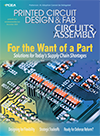Features Articles
 Mount Pleasant is a village in Racine County, Wisconsin. It is located roughly 30 miles south of Milwaukee and 60 miles north of Chicago.
Mount Pleasant is a village in Racine County, Wisconsin. It is located roughly 30 miles south of Milwaukee and 60 miles north of Chicago.
Until earlier this year, Mount Pleasant was perhaps best known for once being the home to the late Henry Herzog, who once owned a farm there. For those unfamiliar with Herzog, he was a Wisconsin State Assemblyman.
In 1915 and 1916.
Mount Pleasant is that kind of place.
Sorry, Mount Pleasant was that kind of place. As readers of this publication know by now, Foxconn plans to start construction on a $10 billion, 20 million sq. ft. LCD manufacturing plant in Mount Pleasant this year. And Racine County just gave its blessing to a deal to offer up to $764 million in financial incentives to support that campus.
As of the 2010 census, there were 26,197 residents of Mount Pleasant. Its population makes up about 13% of the 195,408 citizens in Racine County. That $764 million amounts to $3,910 of new debt for every citizen of Racine County. Worse, it represents $29,163 of new debt for every citizen of Mount Pleasant.
Foxconn says it will employ 3,000 people when the site opens, and if things break right, it could ultimately employ 13,000 at the site. That comes to $58,769 in new debt per job created, best case. Assuming 3,000 new jobs, it’s an outlay of $254,666 per job.
The impact is so blunt, Moody’s Investor Service immediately cut Racine County’s bond rating, meaning it will be more expensive for the county to borrow for future needs.
Wow.
As you are letting that sink in, consider the potentially even bigger wow around the corner. Andrew Ng, once Google’s top artificial intelligence researcher, just launched a new venture to bring AI to the factory floor. And who is his partner? Foxconn.
It’s not immediately clear Ng understands how the typical electronics manufacturing plant works. A company video (at landing.ai) demonstrates a human hand-inspecting a semiconductor package. On the video, Ng says the software can easily be taught to spot defects on PCBs, which he says is often done by “thousands of people at a single factory.” Except it’s not. Inline AOI overcame that issue years ago.
There’s an obvious disconnect between the technology and the need that must be sorted out.
What is true, however, is that work toward not just the smart factory (also known as Industry 4.0), but one dominated by AI, will accelerate. The value proposition is too great to ignore. And that’s where matters become, well, uncomfortable.
Ng says that while AI technology is likely to disrupt traditional human-run operations, his new company is seeking ways to prepare displaced employees for higher-skilled work. If he succeeds, that would be great. I wouldn’t bet on it. In a perverse way, capital flows to those who appear best-positioned to blow up old industries, which typically results in lower labor costs, or greater automation, or both. As a startup, Ng’s investors will drive his research.
As Michael Ford notes in our cover story this month, Industry 4.0 married with AI could spell the end of employment, not just for line operators but also higher-level workers such as supervisors, managers and engineers. “The question,” he asks, “is whether this in fact will be necessary, or whether there are ways in which it could be avoided, or at least reduced.”
During its recruitment of Foxconn, Wisconsin state transportation officials were surprised by the ODM’s request for driverless lanes from the new campus to key regional transportation hubs. If the Landing-Foxconn partnership succeeds, those driverless cars might be human-free as well.
We’ve come a long way from the early 2000s, when China pushed factories to buy semiautomatic equipment. The reasoning, as old friend Gene Weiner pointed out to me at the time, was simple: jobs. When you have 1.3 billion people to keep happy, the benefits of automation aren’t necessarily prioritized. Now we are spending hundreds of millions of dollars to underwrite corporations that might accelerate the obsolescence of humans in building electronics. In doing business with Foxconn, the citizens of Mount Pleasant might find it anything but.
Mike Buetow
Editor-In-Chief
P.S. A couple of housekeeping notes. In our December issue, a column from Roy Akber borrowed heavily from previous work by Craig Armenti. Our sincere apologies to Craig for the unattributed use of his ideas.
And we continue to add interviews to our podcast series, PCB Chat. Stop by upmg.podbean.com to hear the latest, including my chat with Randall Sherman on the state of the EMS/ODM market.
 In part I, the author reviews design steps and material choices.
In part I, the author reviews design steps and material choices.
Printed circuit boards are produced in different forms, e.g., rigid, flexible, rigid-flex, and high-density interconnect (HDI). The primary differences are in the materials used to fabricate them; these materials, by their properties, give PCBs their ability to flex or to remain rigid.
Regardless of the materials used, the primary steps in the PCB manufacturing process are generally the same. But before PCBs reach the manufacturing stage, the PCB designer must make some choices depending on the application:
- Selecting the type of PCB required by the application;
- Deciding the number of layers (one, two, four or more);
- Deciding the mechanical layout, the stackup, and the routing of tracks on different layers;
- Producing relevant documents and files for the manufacturing process.
 The HKPCA Show revealed just how far robotics for the PCB shop has come.
The HKPCA Show revealed just how far robotics for the PCB shop has come.
Industry exhibitions never disappoint, and during the last couple months of 2017 two of the biggest ones took place. Seeing the multitude of options that other parts of the world have in the way of equipment, materials and supplies is always staggering. I am always amazed how many suppliers of drill bits and drilling machines exist – matched only by the number of suppliers of via fill chemistries and paste.
Equally impressive is seeing what’s new. These days the really groundbreaking concepts, equipment and materials seem to be first launched anywhere but in North America, more often than not in Asia. While walking the aisles of the HKPCA Show in December and drooling over the multitude of opportunities to invest the capital dollars I wish I had, on equipment not available back home, I observed some interesting and definitely new equipment that was being described in a decidedly old way as robotics.
 These process indicators on QFNs could suggest maintenance is needed.
These process indicators on QFNs could suggest maintenance is needed.
The image in FIGURE 1 shows tin plating slivers on the body of a QFN component. During introduction, we have experienced slivers between the terminations by as much as 50%. FIGURE 2 shows burrs on the terminations, which are not uncommon but are again an indication of poor manufacturing quality control.
Press Releases
- Critical Manufacturing Partners with Canonical to Expand Cloud-Native Deployment Options for Manufacturers
- Heller Industries Becomes the Latest Partner to Join THE SMT FUTURE EXPERIENCE
- AIM Solder Signs New Distributor in Vietnam
- Variosystems launches AI platform for secure and connected supply chain services



